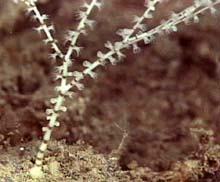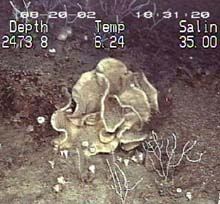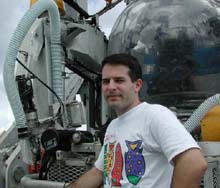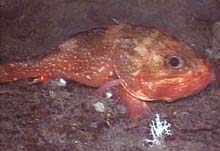“Got It!”
August 21, 2002
Arte Roman
High School Marine Science Teacher
Olympia High School, Orlando, Florida
![]() Watch video footage captured by the Johnson-Sea-Link II. (mp4, 1.4 MB)
Watch video footage captured by the Johnson-Sea-Link II. (mp4, 1.4 MB)
Why would anyone want to spend two weeks away from land, in crowded quarters, while sometimes working until 2 a.m.? Well, for me it’s something that I have always wanted to do. I love waking up in the morning, stepping out on deck, and seeing a whole ocean as your backyard. I love the prospect of discovering things that have never before been seen by humans. Although I have been at sea before, it has never been for this long and with so many great scientists.
I am grateful for the opportunity that NOAA and Dr. Widder have given me. This expedition will allow me to gain invaluable experiences not only for myself, but for my students as well. I believe it’s important for every marine science teacher to have had some upper level research experience with the marine environment. This turns the teacher into a beneficial resource from whom students will want to learn from. They can trust the teacher’s insight into what the ocean realm is really like.
When students have questions, it’s nice to give them answers from first-hand experiences and not just answers from a book. My hope is that my participation in this Expedition will draw awareness to the value of exploring our ocean ecosystem and excite students into following their dreams of becoming scientists.
My primary duties on board the R/V Seward Johnson are to assist Dr. Widder with her bioluminescence work and to help other scientists with their projects as needed. I am also assisting with writing daily logs, like this one, while answering some of the hundreds of questions that my students wrote for me before I left – questions like “How much fuel is needed for the expedition?”, “How deep can the submersible go?”, “Can you take your family with you?”, and “Do you do research at night?”
Life on board is not at all bad. We get three excellent meals a day and we can snack at any time. Our small cabin is a very snug fit for four people, but we are never there that often anyway. When we are waiting for the submersible to come back up with samples, I can watch satellite TV or sit outside and converse with other scientists. The only time it ever gets boring is when I have no work to do.
This morning I made my first submersible dive, which I will write about later. The mission for the dive was conveyed during the morning pre-dive briefing: descend to 2,160 feet, locate the Eye-in-the-Sea camera, collect samples in the surrounding area, retrieve the camera, and return to the surface. The descent to the bottom was smooth, but once we reached the bottom we noticed the current was much stronger than we had originally expected. We tried many different approaches to reach the camera, but it was not meant to be. The current was too strong and unpredictable. So the morning dive was cut short and we were back on the deck by 10:00 a.m. The most frustrating thing is that you cannot see what pictures you have collected until you download the data from the camera and you cannot take more pictures until you bring the camera up on board and change the battery.
The second dive occurred at noon and had one mission and one mission only – retrieve the “Eye-in-the-Sea” camera. After over an hour and a half of searching, submersible pilot Craig Caddigan radioed back two words that meant volumes to Dr. Widder – “Got it!” In less than two hours, the Johnson-Sea-Link II was back on deck with the camera. We are hopeful that we can download the data from the camera, which is presently not responding to Dr. Widder’s commands via a computer that has been connected to the camera in the lab. All are anxious for a response from the instruments.
Life at sea is definitely not for everyone, but it sure is for me. My interaction with the scientists on board is far more valuable than any classroom experience. I truly hope that my students at Olympia High School and students around the world benefit from following the Expedition. I should have many stories to tell when I get back!
During exploration of shelf-edge reefs, we will map bottom features and oceanographic features such as upwelling areas, and observe fish to determine if spawning is occurring. We hope to measure physical conditions, such as bottom type and circulation, that result in the formation of aggregations of spawning fishes, so that such aggregations can be managed for sustained fisheries.
Sign up for the Ocean Explorer E-mail Update List.


















































